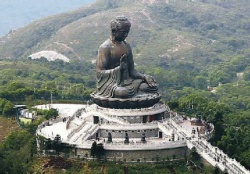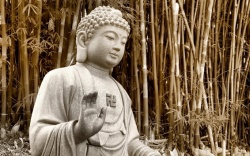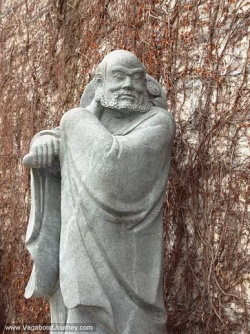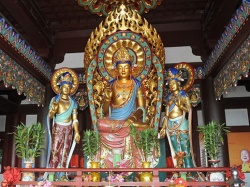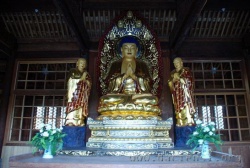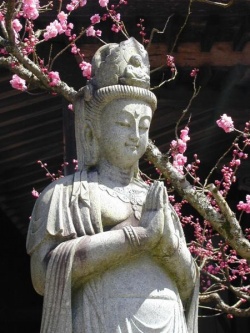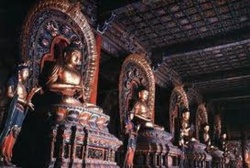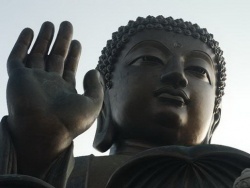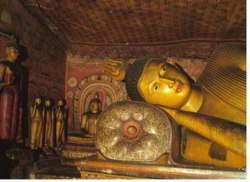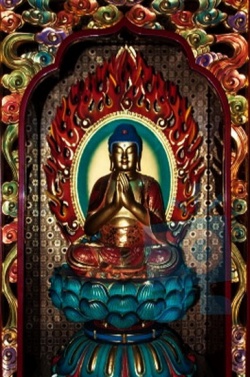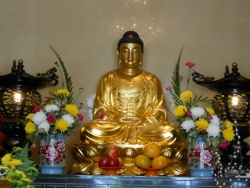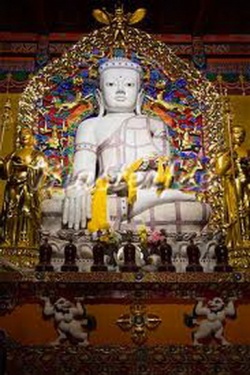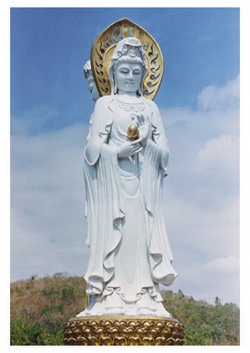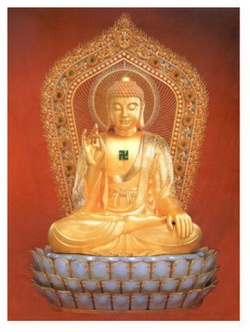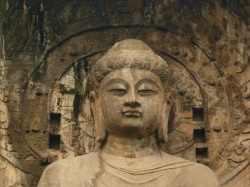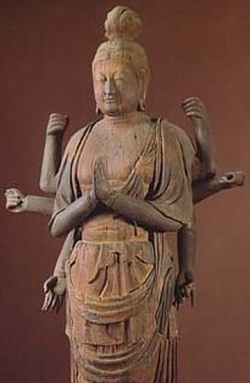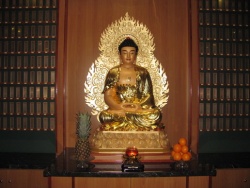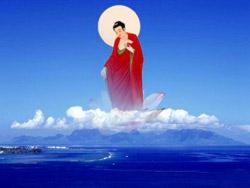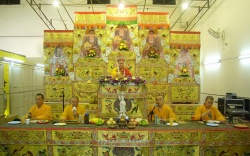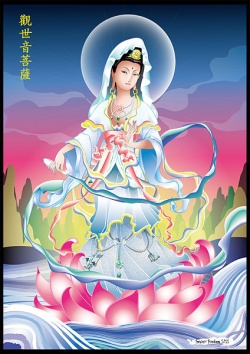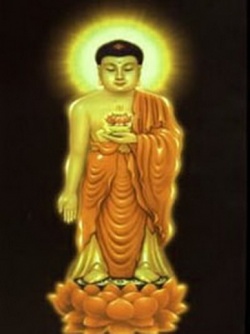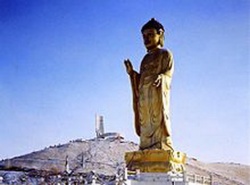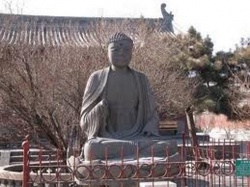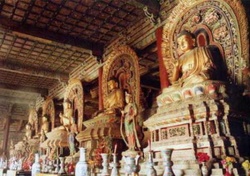Difference between revisions of "Path of Easy Practice"
| Line 22: | Line 22: | ||
So it is with [[bodhisattvas]]; concerning the stages of a [[shravaka]] or a [[pratyekabuddha]], they should have a great {{Wiki|fear}}. (5) | So it is with [[bodhisattvas]]; concerning the stages of a [[shravaka]] or a [[pratyekabuddha]], they should have a great {{Wiki|fear}}. (5) | ||
[[File:Dacien Temple37.jpg|thumb|250px|]] | [[File:Dacien Temple37.jpg|thumb|250px|]] | ||
| − | Such {{Wiki|being}} the case, if there is in the teachings of the [[Buddhas]] a [[path]] of | + | Such {{Wiki|being}} the case, if there is in the teachings of the [[Buddhas]] a [[path]] of easy practice whereby one quickly enters the Stage of Non-retrogression, please explain it to me. Answer: Your remarks are those of a weak and cowardly man without great [[aspiration]]; they are not the words of a man of {{Wiki|courage}} and {{Wiki|determination}}. The [[reason]] I say this is that if a man makes a [[vow]] in his {{Wiki|desire}} to reach the [[highest]] perfect [[Bodhi]], he should, until he enters the Stage of Non-retrogression, exert himself day and night, without regard for his [[life]], as if to put out a [[fire]] on his {{Wiki|head}}. As it is said in the Aids to [[Realizing]] [[Bodhi]]: |
[[File:Daienin Kannon.JPG|thumb|250px|]] | [[File:Daienin Kannon.JPG|thumb|250px|]] | ||
If [[bodhisattvas]] have not yet entered the Stage of Non-retrogression, | If [[bodhisattvas]] have not yet entered the Stage of Non-retrogression, | ||
| Line 35: | Line 35: | ||
To make [[vows]] and seek the [[Path]] to [[Buddhahood]] is a task harder than lifting the whole {{Wiki|universe}}. | To make [[vows]] and seek the [[Path]] to [[Buddhahood]] is a task harder than lifting the whole {{Wiki|universe}}. | ||
[[File:DDHA.jpeg|thumb|250px|]] | [[File:DDHA.jpeg|thumb|250px|]] | ||
| − | You say that the Stage of Non-retrogression is extremely difficult to enter, requiring a long period of practice, and ask me if there is a [[path]] of | + | You say that the Stage of Non-retrogression is extremely difficult to enter, requiring a long period of practice, and ask me if there is a [[path]] of easy practice whereby you can attain this stage quickly. These are words of a cowardly and contemptible man, and not those of a brave man with a strong [[aspiration]]. If, however, you insist on {{Wiki|hearing}} from me about this method of practice, I will explain it to you. |
| − | There are innumerable modes of entry into the [[Buddha's teaching]]. Just as there are in the {{Wiki|world}} difficult and easy [[paths]] - travelling on foot by land is full of hardship and travelling in a boat by sea is [[pleasant]] - so it is among the [[paths]] of the [[bodhisattvas]]. Some exert themselves diligently, while others quickly enter Non-retrogression by the | + | There are innumerable modes of entry into the [[Buddha's teaching]]. Just as there are in the {{Wiki|world}} difficult and easy [[paths]] - travelling on foot by land is full of hardship and travelling in a boat by sea is [[pleasant]] - so it is among the [[paths]] of the [[bodhisattvas]]. Some exert themselves diligently, while others quickly enter Non-retrogression by the easy practice based on {{Wiki|faith}}. |
(2) The Ten [[Buddhas of the Ten Directions]] | (2) The Ten [[Buddhas of the Ten Directions]] | ||
[[File:Diff3.jpg|thumb|250px|]] | [[File:Diff3.jpg|thumb|250px|]] | ||
| Line 146: | Line 146: | ||
You should reverently {{Wiki|worship}} those [[Buddhas]], such as [[Amitabha]], and recite their names. I will present them in full: 1. the [[Buddha Amitayus]], 2. the {{Wiki|Buddha}} [[Lokeshvararaja]], 3. the {{Wiki|Buddha}} Simhamati, 4. the {{Wiki|Buddha}} [[Dharmamati]], 5. the {{Wiki|Buddha}} Brahmaketu, 6. the {{Wiki|Buddha}} Lokaketu, 7. the {{Wiki|Buddha}} Lokasundara, 8. the {{Wiki|Buddha}} Karunika, 9. the {{Wiki|Buddha}} Lokendra, 10. the {{Wiki|Buddha}} Narendra, 11. the {{Wiki|Buddha}} Candrashri, 12. the {{Wiki|Buddha}} Ratnashri, 13. the {{Wiki|Buddha}} Ketushri, 14. the {{Wiki|Buddha}} Mahaketu, 15. the {{Wiki|Buddha}} Muktacchatra, 16. the {{Wiki|Buddha}} Kesharin, 17. the {{Wiki|Buddha}} Ajnanavidhvamsana, 18. the {{Wiki|Buddha}} Kusumabhijna, 19. the {{Wiki|Buddha}} Tamalapatracandanakardama, 20. the {{Wiki|Buddha}} Mahagunadhara, 21. the {{Wiki|Buddha}} Saptaratnabhivrsta, 22. the {{Wiki|Buddha}} Vikranta, 23. the {{Wiki|Buddha}} Vyapagatakhiladosa, 24. the {{Wiki|Buddha}} Mahavyuha, 25. the {{Wiki|Buddha}} Nirnimitta, 26. the {{Wiki|Buddha}} Ratnagarbha, 27. the {{Wiki|Buddha}} Shrikuta. 28. the {{Wiki|Buddha}} Tagaragandha, 29. the {{Wiki|Buddha}} Candanagandha, 30. the {{Wiki|Buddha}} Padmagandha, 31. the {{Wiki|Buddha}} Vithyupashobhita, 32. the {{Wiki|Buddha}} Nagacchatra, 33. the {{Wiki|Buddha}} Kusumavristi, 34. the {{Wiki|Buddha}} Kusumabhiprakirna, 35. the {{Wiki|Buddha}} Kusumaprabha, 36. the {{Wiki|Buddha}} Suryaghosa, 37. the {{Wiki|Buddha}} Candrasuryajihmikarana, 38. the {{Wiki|Buddha}} Vaiduryagarbha, 39. the {{Wiki|Buddha}} [[Brahmaghosa]], 40. the {{Wiki|Buddha}} Vimalaprabhasa, 41. the {{Wiki|Buddha}} Suvarnagarbha, 42. the {{Wiki|Buddha}} Merukuta, 43. the {{Wiki|Buddha}} Giriraja, 44. the {{Wiki|Buddha}} Ghoseshvara, 45. the {{Wiki|Buddha}} [[Vimalanetra]], 46. the {{Wiki|Buddha}} [[Candraprabha]], 47. the {{Wiki|Buddha}} Sumerukalpa, 48. the {{Wiki|Buddha}} Candrabhanu, 49. the {{Wiki|Buddha}} Praptasena, 50. the {{Wiki|Buddha}} Kusumasambhava, 51. the {{Wiki|Buddha}} Brahmasvaranadabhinadita, 52. the {{Wiki|Buddha}} Lokendra, 53. the {{Wiki|Buddha}} Simhavikrama, 54. the {{Wiki|Buddha}} Saddharmamatisimhanada, 55. the {{Wiki|Buddha}} Muktacchatrapravadavarna, 56. the {{Wiki|Buddha}} Avidyaragandhakaravidhvamsanakara, 57. the {{Wiki|Buddha}} Udakacandra, 58. the {{Wiki|Buddha}} Puspakara, 59. the {{Wiki|Buddha}} Samkusumitabhijna, 60. the {{Wiki|Buddha}} Citraratnadhara, 61. the {{Wiki|Buddha}} [[Buddhi]], 62. the {{Wiki|Buddha}} Kusumabhyudgata, 63. the {{Wiki|Buddha}} Uttamavaiduryanirbhasa, 64. the {{Wiki|Buddha}} Suryajihmikarana, 65. the {{Wiki|Buddha}} Mahagunadhara, 66. the {{Wiki|Buddha}} Buddhiprapta, 67. the {{Wiki|Buddha}} Shura, 68. the {{Wiki|Buddha}} Vyapagatashathya, 69. the {{Wiki|Buddha}} Ranamjaha, 70. the {{Wiki|Buddha}} Mahagandha, 71. the {{Wiki|Buddha}} Nirbhasa, 72. the {{Wiki|Buddha}} Variprabha, 73. the {{Wiki|Buddha}} Sagaravaridharabuddhivikridita, 74. the {{Wiki|Buddha}} Shrikutakusuma, 75. the {{Wiki|Buddha}} Kusumapratimandita, 76. the {{Wiki|Buddha}} Suryaghosa, 77. the {{Wiki|Buddha}} Candrabhibhu, 78. the {{Wiki|Buddha}} [[Vaidurya]], 79. the {{Wiki|Buddha}} [[Brahmaghosa]], 80. the {{Wiki|Buddha}} Jyotisprabha, 81. the {{Wiki|Buddha}} Suvarnagarbha, 82. the {{Wiki|Buddha}} Merukuta, 83. the {{Wiki|Buddha}} Giriraja, 84. the {{Wiki|Buddha}} Ghosaraja, 85. the {{Wiki|Buddha}} Nagabhibhu, 86. the {{Wiki|Buddha}} Anupalipta, 87. the {{Wiki|Buddha}} Vimalanana, 88. the {{Wiki|Buddha}} Candranana, 89. the {{Wiki|Buddha}} Sumerukalpa, 90. the {{Wiki|Buddha}} Candanagandha, 91. the {{Wiki|Buddha}} Pratapavat, 92. the {{Wiki|Buddha}} [[Dipankara]], 93. the {{Wiki|Buddha}} Dusprasaha, 94. the {{Wiki|Buddha}} Ratnashri, 95. the {{Wiki|Buddha}} Anandaghosa, 96. the {{Wiki|Buddha}} Jyotisprabha, 97. the {{Wiki|Buddha}} Nagabhibhu, 98. the {{Wiki|Buddha}} Virajahprabha, 99. the {{Wiki|Buddha}} [[Simha]], 100. the {{Wiki|Buddha}} Rajendra, 101. the {{Wiki|Buddha}} Balabhibhu, 102. the {{Wiki|Buddha}} Puspadanta, 103. the {{Wiki|Buddha}} Vaisharadyaprabha, 104. the {{Wiki|Buddha}} Gandhakuta, 105. the {{Wiki|Buddha}} [[Samantabhadra]], 106. the {{Wiki|Buddha}} Samantakusuma, and 107. the {{Wiki|Buddha}} [[Ratnaketu]]. These [[Buddhas]] and Bhagavats are now dwelling in their [[pure lands]] in the [[ten directions]]. You should all recite their names and be [[mindful]] of them. | You should reverently {{Wiki|worship}} those [[Buddhas]], such as [[Amitabha]], and recite their names. I will present them in full: 1. the [[Buddha Amitayus]], 2. the {{Wiki|Buddha}} [[Lokeshvararaja]], 3. the {{Wiki|Buddha}} Simhamati, 4. the {{Wiki|Buddha}} [[Dharmamati]], 5. the {{Wiki|Buddha}} Brahmaketu, 6. the {{Wiki|Buddha}} Lokaketu, 7. the {{Wiki|Buddha}} Lokasundara, 8. the {{Wiki|Buddha}} Karunika, 9. the {{Wiki|Buddha}} Lokendra, 10. the {{Wiki|Buddha}} Narendra, 11. the {{Wiki|Buddha}} Candrashri, 12. the {{Wiki|Buddha}} Ratnashri, 13. the {{Wiki|Buddha}} Ketushri, 14. the {{Wiki|Buddha}} Mahaketu, 15. the {{Wiki|Buddha}} Muktacchatra, 16. the {{Wiki|Buddha}} Kesharin, 17. the {{Wiki|Buddha}} Ajnanavidhvamsana, 18. the {{Wiki|Buddha}} Kusumabhijna, 19. the {{Wiki|Buddha}} Tamalapatracandanakardama, 20. the {{Wiki|Buddha}} Mahagunadhara, 21. the {{Wiki|Buddha}} Saptaratnabhivrsta, 22. the {{Wiki|Buddha}} Vikranta, 23. the {{Wiki|Buddha}} Vyapagatakhiladosa, 24. the {{Wiki|Buddha}} Mahavyuha, 25. the {{Wiki|Buddha}} Nirnimitta, 26. the {{Wiki|Buddha}} Ratnagarbha, 27. the {{Wiki|Buddha}} Shrikuta. 28. the {{Wiki|Buddha}} Tagaragandha, 29. the {{Wiki|Buddha}} Candanagandha, 30. the {{Wiki|Buddha}} Padmagandha, 31. the {{Wiki|Buddha}} Vithyupashobhita, 32. the {{Wiki|Buddha}} Nagacchatra, 33. the {{Wiki|Buddha}} Kusumavristi, 34. the {{Wiki|Buddha}} Kusumabhiprakirna, 35. the {{Wiki|Buddha}} Kusumaprabha, 36. the {{Wiki|Buddha}} Suryaghosa, 37. the {{Wiki|Buddha}} Candrasuryajihmikarana, 38. the {{Wiki|Buddha}} Vaiduryagarbha, 39. the {{Wiki|Buddha}} [[Brahmaghosa]], 40. the {{Wiki|Buddha}} Vimalaprabhasa, 41. the {{Wiki|Buddha}} Suvarnagarbha, 42. the {{Wiki|Buddha}} Merukuta, 43. the {{Wiki|Buddha}} Giriraja, 44. the {{Wiki|Buddha}} Ghoseshvara, 45. the {{Wiki|Buddha}} [[Vimalanetra]], 46. the {{Wiki|Buddha}} [[Candraprabha]], 47. the {{Wiki|Buddha}} Sumerukalpa, 48. the {{Wiki|Buddha}} Candrabhanu, 49. the {{Wiki|Buddha}} Praptasena, 50. the {{Wiki|Buddha}} Kusumasambhava, 51. the {{Wiki|Buddha}} Brahmasvaranadabhinadita, 52. the {{Wiki|Buddha}} Lokendra, 53. the {{Wiki|Buddha}} Simhavikrama, 54. the {{Wiki|Buddha}} Saddharmamatisimhanada, 55. the {{Wiki|Buddha}} Muktacchatrapravadavarna, 56. the {{Wiki|Buddha}} Avidyaragandhakaravidhvamsanakara, 57. the {{Wiki|Buddha}} Udakacandra, 58. the {{Wiki|Buddha}} Puspakara, 59. the {{Wiki|Buddha}} Samkusumitabhijna, 60. the {{Wiki|Buddha}} Citraratnadhara, 61. the {{Wiki|Buddha}} [[Buddhi]], 62. the {{Wiki|Buddha}} Kusumabhyudgata, 63. the {{Wiki|Buddha}} Uttamavaiduryanirbhasa, 64. the {{Wiki|Buddha}} Suryajihmikarana, 65. the {{Wiki|Buddha}} Mahagunadhara, 66. the {{Wiki|Buddha}} Buddhiprapta, 67. the {{Wiki|Buddha}} Shura, 68. the {{Wiki|Buddha}} Vyapagatashathya, 69. the {{Wiki|Buddha}} Ranamjaha, 70. the {{Wiki|Buddha}} Mahagandha, 71. the {{Wiki|Buddha}} Nirbhasa, 72. the {{Wiki|Buddha}} Variprabha, 73. the {{Wiki|Buddha}} Sagaravaridharabuddhivikridita, 74. the {{Wiki|Buddha}} Shrikutakusuma, 75. the {{Wiki|Buddha}} Kusumapratimandita, 76. the {{Wiki|Buddha}} Suryaghosa, 77. the {{Wiki|Buddha}} Candrabhibhu, 78. the {{Wiki|Buddha}} [[Vaidurya]], 79. the {{Wiki|Buddha}} [[Brahmaghosa]], 80. the {{Wiki|Buddha}} Jyotisprabha, 81. the {{Wiki|Buddha}} Suvarnagarbha, 82. the {{Wiki|Buddha}} Merukuta, 83. the {{Wiki|Buddha}} Giriraja, 84. the {{Wiki|Buddha}} Ghosaraja, 85. the {{Wiki|Buddha}} Nagabhibhu, 86. the {{Wiki|Buddha}} Anupalipta, 87. the {{Wiki|Buddha}} Vimalanana, 88. the {{Wiki|Buddha}} Candranana, 89. the {{Wiki|Buddha}} Sumerukalpa, 90. the {{Wiki|Buddha}} Candanagandha, 91. the {{Wiki|Buddha}} Pratapavat, 92. the {{Wiki|Buddha}} [[Dipankara]], 93. the {{Wiki|Buddha}} Dusprasaha, 94. the {{Wiki|Buddha}} Ratnashri, 95. the {{Wiki|Buddha}} Anandaghosa, 96. the {{Wiki|Buddha}} Jyotisprabha, 97. the {{Wiki|Buddha}} Nagabhibhu, 98. the {{Wiki|Buddha}} Virajahprabha, 99. the {{Wiki|Buddha}} [[Simha]], 100. the {{Wiki|Buddha}} Rajendra, 101. the {{Wiki|Buddha}} Balabhibhu, 102. the {{Wiki|Buddha}} Puspadanta, 103. the {{Wiki|Buddha}} Vaisharadyaprabha, 104. the {{Wiki|Buddha}} Gandhakuta, 105. the {{Wiki|Buddha}} [[Samantabhadra]], 106. the {{Wiki|Buddha}} Samantakusuma, and 107. the {{Wiki|Buddha}} [[Ratnaketu]]. These [[Buddhas]] and Bhagavats are now dwelling in their [[pure lands]] in the [[ten directions]]. You should all recite their names and be [[mindful]] of them. | ||
| − | (4) The [[path]] of | + | (4) The [[path]] of easy practice based on [[Amida's]] [[Vow]] |
[[Amida Buddha's]] Primal [[Vow]] is as follows: | [[Amida Buddha's]] Primal [[Vow]] is as follows: | ||
Revision as of 12:21, 14 December 2013
The Ninth Chapter of the Discourse on the Ten Stages
by Nagarjuna
translated from Chinese
by Hisao Inagaki
(Revised in July, 1998)
(1) The Path of Difficult Practice and the Path of Easy Practice
Question: The initial tasks for bodhisattvas seeking the Stage of Non-retrogression have been explained above. Those who seek this stage can only reach it after performing various difficult practices for a long time. [In the course of practice] some fall into the stages of a shravaka or a pratyekabuddha. If they do, this is a serious regression. As explained in the Aids to Realizing Bodhi:
If you have fallen into the stages of a shravaka or a pratyekabuddha,
This is called the 'death of the bodhisattva,' for he loses all merit. (1)
Even if you fell into hell, such a fear would not arise;
Regression to the stages of the Two Vehicles4) should be greatly feared. (2)
Even if you have fallen into hell, you will eventually be able to reach Buddhahood;
If you have fallen into the stages of the Two Vehicles, the Buddhist Path will be blocked forever. (3)
As the Buddha himself explains in a sutra:
'Just as a man who is strongly attached to his life will be greatly terrified if he is to be beheaded, (4)
So it is with bodhisattvas; concerning the stages of a shravaka or a pratyekabuddha, they should have a great fear. (5)
Such being the case, if there is in the teachings of the Buddhas a path of easy practice whereby one quickly enters the Stage of Non-retrogression, please explain it to me. Answer: Your remarks are those of a weak and cowardly man without great aspiration; they are not the words of a man of courage and determination. The reason I say this is that if a man makes a vow in his desire to reach the highest perfect Bodhi, he should, until he enters the Stage of Non-retrogression, exert himself day and night, without regard for his life, as if to put out a fire on his head. As it is said in the Aids to Realizing Bodhi:
If bodhisattvas have not yet entered the Stage of Non-retrogression,
They should always strive and be diligent as though putting out a fire on their heads. (6)
Since they carry heavy burdens in pursuit of Bodhi,
They should always strive and be diligent, and never entertain a thought of indolence. (7)
Even a man seeking the enlightenment of the shravaka or pratyekabuddha Should always strive and be diligent, though it is merely for his own benefit. (8)
How much more so for bodhisattvas who seek to ferry themselves and others over to Bodhi! They should strive a million times more diligently than followers of the Two Vehicles. (9)
To the practicers of Mahayana, the Buddha said:
To make vows and seek the Path to Buddhahood is a task harder than lifting the whole universe.
You say that the Stage of Non-retrogression is extremely difficult to enter, requiring a long period of practice, and ask me if there is a path of easy practice whereby you can attain this stage quickly. These are words of a cowardly and contemptible man, and not those of a brave man with a strong aspiration. If, however, you insist on hearing from me about this method of practice, I will explain it to you.
There are innumerable modes of entry into the Buddha's teaching. Just as there are in the world difficult and easy paths - travelling on foot by land is full of hardship and travelling in a boat by sea is pleasant - so it is among the paths of the bodhisattvas. Some exert themselves diligently, while others quickly enter Non-retrogression by the easy practice based on faith.
(2) The Ten Buddhas of the Ten Directions
As explained in verse:
The Buddha Bhadrashri in the east, the Buddha Candrashri in the south,
The Buddha Anantaujas in the west, and Ketushri in the north, (10)
The Buddha Ashokashri in the southeast, the Buddha Ratnadatta in the southeast,
The Buddha Kusumashri in the northwest, the Buddha Yanatrayacarya in the northeast, (11)
The Buddha Prabhasashri at the nadir, and the Buddha Vipulaganashri at the zenith -
The World-Honored Ones such as these dwell at present in the ten directions. (12)
Those who wish to enter the Stage of Non-retrogression quickly Should reverently hold them in mind and recite their names. (13)
If a bodhisattva wishes to enter in his present body the Stage of Non-retrogression and realize the highest perfect Bodhi, he should be mindful of those Buddhas of the ten directions and recite their names.
In the chapter called "Non-retrogression" in the Sutra on the Questions of the Boy Ratnacandra it is said:
The Buddha addressed Ratnacandra thus: Eastward from here, after going past innumerable, immeasurable and incalculable Buddha-lands, multiplied by the number of the sand-grains of the River Ganges, there is a land called Ashoka. The land is flat and is of seven treasures. Purple-gold ropes intersect to mark roads and areas, and rows of jewelled trees form beautiful ornaments. There is no hell, no realms of animals, no hungry and fighting spirits, nor any of the other states of suffering. The land is immaculate and free from defilement, without sand, pebbles, tiles, or stones; nor are there mountains, hills, deep pits or ravines. Flowers always shower down from the sky and are strewn over the ground. At present there lives a Buddha named Bhadrashri, the Tathagata, Arhat, Fully Enlightened, Perfect in Wisdom and Conduct, Sugata, Knower of the World, Unsurpassedr of Men, Teacher of Gods and Men, Buddha and World-Honored One. A host of great bodhisattvas worship and encircle him. His physical glory is like a great brilliant gold mountain or like a huge mass of rare treasures. He expounds to the assembly the Dharma, which is good in its beginning, good in its middle and good in its end. He expounds it in appropriate words full of deep meaning. His exposition is unadulterated, pure, truthful and without mistake. How is it without mistake? He truthfully presents earth, fire and wind; likewise he expounds the worlds of desire, form and non-form as well as physical form, perception, conception, volition and consciousness.
O Ratnacandra, sixty kotis of kalpas have passed since the Buddha Bhadrashri attained Buddhahood. In his Buddha-land there is neither distinct day nor night. The foregoing measurement of his life is simply given in terms of days, months and years as counted in this world called Jambu. The Buddha's light always shines in that land. By one sermon, he leads immeasurable, innumerable, a hundred thousand kotis of incalculable sentient beings to attain insight into the non-arising of of all dharmas. Furthermore, he makes twice as many sentient beings dwell in the first, second and third insights into the nature of dharmas.
O Ratnacandra, by the power of the Buddha's original vow, those beings in other worlds who planted various roots of goodness in the fields of the Buddhas of the past attain insight into the non-arising of all dharmas when they are illumined by his light.
O Ratnacandra, if there are good men and women who, having heard the name of this Buddha, place their faith in him, they will reach the highest perfect Bodhi without regression. The nine other Buddhas are likewise. I will explain the names of these [ten] Buddhas and their lands.
1. The Buddha Bhadrashri: His glorious virtue (shri) is truly good (bhadra), embodying only peace and bliss, unlike the merit and glory of heavenly beings and dragon-gods, which sometimes cause harassment to sentient beings.
2. The Buddha Candanashri: In the south, after passing innumerable and immeasurable Buddha-lands, multiplied by the number of the sand-grains of the River Ganges, there is a land called Nanda. The Buddha of that land is called Candanashri. At present he lives there teaching the Dharma. [His glorious virtue is] like sandalwood (candana) which is fragrant and refreshing. His name reaches everywhere, just as scent pervades far and wide, removing the three fiery passions of sentient beings and enabling them to attain serenity of heart.
3. The Buddha Anantaujas: In the west, after passing innumerable and immeasurable Buddha-lands, multiplied by the number of the sand-grains of the River Ganges, there is a land called Bhadra. The Buddha of that land is called Anantaujas. At present he lives there teaching the Dharma. The brilliance (ojas) of his bodily light and wisdom is immeasurable (ananta) and boundless.
4. The Buddha Ketushri: In the north, after passing innumerable and immeasurable Buddha-lands, multiplied by the number of the sand-grains of the River Ganges, there is a land called Aksobhya. The Buddha of that land is called Ketushri. At present he lives there teaching the Dharma. His merit and virtue (shri) are exalted and manifest like a banner (ketu).
5. The Buddha Ashokashri: In the southeast, after passing innumerable and immeasurable Buddha-lands, multiplied by the number of the sand-grains of the River Ganges, there is a land called Candrabhasa. The Buddha of that land is called Ashokashri. At present he lives there teaching the Dharma. His divine virtue removes the afflictions (shoka) and griefs of all heavenly and human beings.
6. The Buddha Ratnadatta: In the southwest, after passing innumerable and immeasurable Buddha-lands, multiplied by the number of the sand-grains of the River Ganges, there is a land called Ratnadatta. The Buddha of that land is called Ashokashri. At present he lives there teaching the Dharma. He always gives (datta) his people undefiled spiritual treasures (ratna), such as the [five] roots of virtue, the [five] powers, the [seven] practices leading to Enlightenment, and the [Eightfold Noble] Path.
7. The Buddha Kusumashri: In the northwest, after passing innumerable and immeasurable Buddha-lands, multiplied by the number of the sand-grains of the River Ganges, there is a land called Ghosavati. The Buddha of that land is called Kusumashri. At present he lives there teaching the Dharma. His body is like a beautiful flower (kusuma) and his virtue (shri) is limitless.
8. The Buddha Yanatrayacarya: In the northeast, after passing innumerable and immeasurable Buddha-lands, multiplied by the number of the sand-grains of the River Ganges, there is a land called Ksemavati. The Buddha of that land is called Yanatrayacarya. At present he lives there teaching the Dharma. He always expounds methods of practice (carya) for shravakas, pratyekabuddhas and bodhisattvas (yanatraya). Some explain that this Buddha is so called because he teaches everyone the upper, middle and lower grades of endeavor [in accordance with their capacities].
9. The Buddha Prabhasashri: At the nadir, after passing innumerable and immeasurable Buddha-lands, multiplied by the number of the sand-grains of the River Ganges, there is a land called Vishalika. The Buddha of that land is called Prabhasashri. At present he lives there teaching the Dharma. 'Prabhasa' (brilliance) describes the Buddha's physical glory, the brilliance of his wisdom and the shining of the jewelled trees [of the land]. He always illumines the world with these three kinds of brilliance.
10. The Buddha Vipulaganashri: At the zenith, after passing innumerable and immeasurable Buddha-lands, multiplied by the number of the sand-grains of the River Ganges, there is a land called Candravati. The Buddha of that land is called Vipulaganashri. At present he lives there teaching the Dharma. As the merit and virtue (shri) of his disciples are broad (vipula), the Buddha is called Vipulaganashri. These are the Buddhas of the ten directions, beginning with the Buddha Bhadrashri and ending with the Buddha Vipulaganashri. If one recites their names with singleness of heart, one will not regress from reaching the highest perfect Bodhi. Here is a further explanation in verse form:
If there are some who are able to hear the exposition of the names of these Buddhas,
They will acquire immeasurable merit, as [the Buddha] explained to Ratnacandra. (14)
I worship these Buddhas who are dwelling in the ten regions at present.
Anyone who recites their names will enter the Stage of Non-retrogression. (15)
In the land called Ashoka in the east there dwells a Buddha named Bhadrashri;
His physical glory is like a gold mountain, and his name prevails unhindered. (16)
Anyone who hears his name will enter the Stage of Non-retrogression.
So I now join hands and worship him, praying that he will remove all my afflictions and sufferings. (17)
In the land called Nanda in the south there dwells a Buddha named Candanashri.
His countenance is as pure and serene as the full moon and his light is infinite. (18)
He cures people of the fever and the agony caused by the three poisons.
Those who hear his name will enter the Stage of Non-retrogression. So I bow down and worship him. (19)
In the land called Bhadra in the west there dwells a Buddha named Anantaujas;
The light of his body and his wisdom are brilliant, shining everywhere without limit. (20)
Those who hear his name will enter the Stage of Non-retrogression.
So I now bow down and worship him, praying that he will destroy the cycles of birth and death. (21)
In the land called Aksobhya in the north there dwells a Buddha named Ketushri;
His body manifests various marks of excellence which form a glorious adornment. (22)
He crushes devils and adversaries, and leads heavenly and human beings to the Right Path.
Those who hear his name will enter the Stage of Non-retrogression. So I bow down and worship him. (23)
In the land called Candanaprabhasa in the southeast there lives a Buddha named Ashokashri;
His light outshines the sun and the moon. Those who encounter it will have their afflictions and sufferings removed. (24)
He always expounds the Dharma to the multitudes, thereby removing their mental and physical pains.
He is praised by the Buddhas of the ten directions. So I bow down and worship him. (25)
In the land called Ketumati in the southwest there lives a Buddha named Ratnadatta.
He always gives the numerous treasures of the Dharma to all beings. (26)
Heavenly beings prostrate themselves before him, bowing their jewel-crowned heads at his feet.
So I now worship the Buddha Ratnadatta by prostrating my whole body on the ground. (27)
In the land called Ghosavati in the northwest there lives a Buddha named Kusumashri;
There are various jewelled trees in the land, which produces the excellent sounds of the Dharma. (28)
He always adorns sentient beings with the blossoms of the seven elements of Bodhi.
The white curl of hair between his eyebrows resembles the moon. So I now prostrate myself and worship him (29)
The land in the northeast called Ksemavati is made up of different treasures;
The Buddha there is called Yanatrayacarya and his body is adorned with innumerable marks of excellence. (30)
The light of his wisdom is immeasurable, dispersing he darkness of ignorance.
Sentient beings there are freed from afflictions and sufferings. So I bow down and worship him (31)
The land at the zenith called Candravati is adorned with various treasures;
Countless shravakas and bodhisattvas of great virtue dwell there. (32)
The lion among these sages is called Vipulaganashri;
He is feared by all devils, and so I bow down and worship him. (33)
In the land at the nadir called Vishalika there dwells a Buddha named Prabhasashri;
The glory of his body is supreme and more brilliant than the mountain of Jambu-gold. (34)
With the sun of wisdom he always makes the flowers of goodness bloom;
His jewelled land is extremely broad and far-reaching. So I bow down and worship him from afar. (35)
Innumerable kalpas ago there was a Buddha named Sagarashri;
Under his guidance, those Buddhas of the present made vows, resolving: (36)
'My life shall be limitless and my light shall shine with boundless intensity.
My land shall be exceedingly pure and those who hear my name shall definitely become Buddhas.' (37)
They dwell at present in the ten regions and possess the ten powers.
So I bow down and worship the Most Honoured Ones among human and heavenly beings. (38)
(3) The one hundred and seven Buddhas
Question: If we hear the names of those ten Buddhas and hold them deeply in our hearts, we shall not regress from reaching the highest perfect Bodhi. Are there names of other Buddhas and bodhisattvas which enable us to enter the Stage of Non-retrogression?
Answer:
There are Amida and other Buddhas and various Great Bodhisattvas; Those who recite their names and are mindful of them single-heartedly also enter the Stage of Non-retrogression. (39)
You should reverently worship those Buddhas, such as Amitabha, and recite their names. I will present them in full: 1. the Buddha Amitayus, 2. the Buddha Lokeshvararaja, 3. the Buddha Simhamati, 4. the Buddha Dharmamati, 5. the Buddha Brahmaketu, 6. the Buddha Lokaketu, 7. the Buddha Lokasundara, 8. the Buddha Karunika, 9. the Buddha Lokendra, 10. the Buddha Narendra, 11. the Buddha Candrashri, 12. the Buddha Ratnashri, 13. the Buddha Ketushri, 14. the Buddha Mahaketu, 15. the Buddha Muktacchatra, 16. the Buddha Kesharin, 17. the Buddha Ajnanavidhvamsana, 18. the Buddha Kusumabhijna, 19. the Buddha Tamalapatracandanakardama, 20. the Buddha Mahagunadhara, 21. the Buddha Saptaratnabhivrsta, 22. the Buddha Vikranta, 23. the Buddha Vyapagatakhiladosa, 24. the Buddha Mahavyuha, 25. the Buddha Nirnimitta, 26. the Buddha Ratnagarbha, 27. the Buddha Shrikuta. 28. the Buddha Tagaragandha, 29. the Buddha Candanagandha, 30. the Buddha Padmagandha, 31. the Buddha Vithyupashobhita, 32. the Buddha Nagacchatra, 33. the Buddha Kusumavristi, 34. the Buddha Kusumabhiprakirna, 35. the Buddha Kusumaprabha, 36. the Buddha Suryaghosa, 37. the Buddha Candrasuryajihmikarana, 38. the Buddha Vaiduryagarbha, 39. the Buddha Brahmaghosa, 40. the Buddha Vimalaprabhasa, 41. the Buddha Suvarnagarbha, 42. the Buddha Merukuta, 43. the Buddha Giriraja, 44. the Buddha Ghoseshvara, 45. the Buddha Vimalanetra, 46. the Buddha Candraprabha, 47. the Buddha Sumerukalpa, 48. the Buddha Candrabhanu, 49. the Buddha Praptasena, 50. the Buddha Kusumasambhava, 51. the Buddha Brahmasvaranadabhinadita, 52. the Buddha Lokendra, 53. the Buddha Simhavikrama, 54. the Buddha Saddharmamatisimhanada, 55. the Buddha Muktacchatrapravadavarna, 56. the Buddha Avidyaragandhakaravidhvamsanakara, 57. the Buddha Udakacandra, 58. the Buddha Puspakara, 59. the Buddha Samkusumitabhijna, 60. the Buddha Citraratnadhara, 61. the Buddha Buddhi, 62. the Buddha Kusumabhyudgata, 63. the Buddha Uttamavaiduryanirbhasa, 64. the Buddha Suryajihmikarana, 65. the Buddha Mahagunadhara, 66. the Buddha Buddhiprapta, 67. the Buddha Shura, 68. the Buddha Vyapagatashathya, 69. the Buddha Ranamjaha, 70. the Buddha Mahagandha, 71. the Buddha Nirbhasa, 72. the Buddha Variprabha, 73. the Buddha Sagaravaridharabuddhivikridita, 74. the Buddha Shrikutakusuma, 75. the Buddha Kusumapratimandita, 76. the Buddha Suryaghosa, 77. the Buddha Candrabhibhu, 78. the Buddha Vaidurya, 79. the Buddha Brahmaghosa, 80. the Buddha Jyotisprabha, 81. the Buddha Suvarnagarbha, 82. the Buddha Merukuta, 83. the Buddha Giriraja, 84. the Buddha Ghosaraja, 85. the Buddha Nagabhibhu, 86. the Buddha Anupalipta, 87. the Buddha Vimalanana, 88. the Buddha Candranana, 89. the Buddha Sumerukalpa, 90. the Buddha Candanagandha, 91. the Buddha Pratapavat, 92. the Buddha Dipankara, 93. the Buddha Dusprasaha, 94. the Buddha Ratnashri, 95. the Buddha Anandaghosa, 96. the Buddha Jyotisprabha, 97. the Buddha Nagabhibhu, 98. the Buddha Virajahprabha, 99. the Buddha Simha, 100. the Buddha Rajendra, 101. the Buddha Balabhibhu, 102. the Buddha Puspadanta, 103. the Buddha Vaisharadyaprabha, 104. the Buddha Gandhakuta, 105. the Buddha Samantabhadra, 106. the Buddha Samantakusuma, and 107. the Buddha Ratnaketu. These Buddhas and Bhagavats are now dwelling in their pure lands in the ten directions. You should all recite their names and be mindful of them.
(4) The path of easy practice based on Amida's Vow
Amida Buddha's Primal Vow is as follows:
If anyone contemplates me, recites my name, and takes refuge in me, he will instantly enter the Stage of Assurance and subsequently attain the highest perfect Bodhi.
For this reason, you should always be mindful of him. I will now praise him in verse.
The Buddha of Infinite Light and Wisdom, whose body is like a mountain of genuine gold,
I worship with my body, speech and heart by joining hands and bowing down toward him. (40)
His glorious golden radiance reaches all the worlds,
Manifesting its forms in accordance with the begins he saves. So I bow down and worship him. (41)
If anyone, after the end of his life, obtains birth in Amida's land,
He will be instantly endowed with immeasurable merit. So I take refuge in Amida. (42)
If anyone is mindful of that Buddha's infinite power and merit,
He will instantly enter the Stage of Assurance. So I am always mindful of Amida. (43)
Even though people of his land may be subject to various sufferings after death,
They will not fall into the evil realm of hell. So I take refuge in him and worship him. (44)
If anyone is born in that land, he will never again fall into the three evil realms
Or the realm of asuras. So I now take refuge in him and worship him. (45)
Human and heavenly beings [in his land] are all alike in physical appearance, each as glorious as a golden mountain.
He is the refuge for all superior beings. So I prostrate myself and worship him. (46)
Those born in his land are endowed with the divine eye and ear.
Nothing in the ten directions can hinder [their sight and hearing]. So I bow down to the Most Holy One of all Sages. (47)
People of that land have supernatural powers of transforming themselves at will, of knowing the thoughts of others,
And of knowing the previous lives of themselves and others. So I take refuge in him and worship him. (48)
Those born in his land are free from attachment to 'myself' and 'mine.'
They do not produce discriminative thoughts. So I bow down and worship him. (49)
There are innumerable shravakas [in his land], who have attained release from the prison of the Three Worlds;
Their eyes are like lotus-petals. So I bow down and worship him. (50)
All the sentient beings of his land have a gentle nature,
And spontaneously perform the ten good deeds. So I bow down to the King of Sages. (51)
They shine brightly and purely through performing good deeds; their number is infinite and incalculable.
They are the most distinguished of all humans. So I take refuge in him. (52)
If anyone, aspiring to become a Buddha, contemplates Amida in his heart,
Amida will instantly manifest himself before him. So I take refuge in him. (53)
By the power of the Buddha's Primal Vow, bodhisattvas of the ten directions
Come to make offerings to him and hear the Dharma. So I bow down to him. (54)
Bodhisattvas of this land possess excellent physical marks and characteristics
Which glorify their bodies. So I now take refuge in him and worship him. (55)
The Great Bodhisattvas of his land can make offerings to the Buddhas of the ten directions
Three times daily. So I bow down and worship him. (56)
If there is anyone who plants roots of goodness but entertains doubts, the flower [he will be born into] will not bloom;
For those who have pure faith, flowers will bloom, and they will see the Buddha. (57)
The present Buddhas of the ten directions praise this Buddha's merit
In various ways. So I now take refuge in him and worship him. (58)
The land is adorned everywhere and is superior to the heavenly palaces;
His merit is exceedingly vast and deep. So I kneel at the Buddha's feet. (59)
Each sole of the Buddha bears the mark of a thousand-spoked wheel and is soft and lotus-colored.
Anyone who sees this rejoices. So I prostrate myself and worship at his feet. (60)
The light emanating from the white curl of hair between his eyebrows resembles that of the pure moon,
And adds to the luster of his countenance. So I kneel down at his feet. (61)
When he was seeking the Path to Buddhahood, he performed many marvelous practices
As described in various sutras. So I prostrate myself and worship him. (62)
The Buddha's sermons destroy the roots of evil;
They are beautifully worded and bring great benefit. So I bow down and worship him. (63)
With these beautifully worded sermons, he cures people's addiction to pleasures;
He saved beings in the past and is saving beings now; all gods kneel down and worship him. (64)
He is the most honored of all human and heavenly beings; all gods kneel down and worship him,
With their crowns made of seven treasures touching his feel. So I take refuge in him. (65)
All wise and holy sages and multitudes of human and heavenly beings
Together take refuge in him. So I, too, worship him. (66)
Boarding the boat of Eightfold Noble Teaching, he ferries people over the sea that is difficult to cross;
He has crossed it himself and now carries others across. So I worship the one who possesses unrestricted power. (67)
Even if all the Buddhas praised his merit for innumerable kalpas,
They could not fully honor it. So I take refuge in the Pure Person. (68)
Like those Buddhas, I have praised his boundless virtue.
By this act, I pray that the Buddha may always think of me. (69)
With whatever merit I have acquired in this and previous lives,
I wish to be in the presence of the Buddha and attain eternal purity of heart. (70)
May the supreme merit I have acquired by this meritorious act
Be shared with all other sentient beings. (71)
(5) The eight Buddhas of the past and future
You should also concentrate on the Buddha Vipashyin, the Buddha Shikhin, the Buddha Vishvabhu, the Buddha Krukucchanda, the Buddha Kanakamuni, the Buddha Kashyapa, the Buddha Shakyamuni, and the future Buddha Maitreya. You should all concentrate on them and worship them. I now praise them in verse.
Vipashyin, the World-Honored One, under an ashoka tree
Attained Omniscience and possesses many supreme merits. (72)
He contemplated the world as it truly is and attained emancipation of mind.
With my entire body, I now pay homage to the Unsurpassed One. (73)
Shikhin, the Buddha and World-Honored One, sitting under
A pundarika tree, realized Enlightenment. (74)
The glory of his body is peerless, resembling a brilliant purple-gold mountain.
I now pay homage to the peerless Honored One of the Three Worlds. (75)
Vishvabhu, the World-Honored One, sitting under a shala tree,
Effortlessly attained all the supreme levels of wisdom. (76)
Among all human and heavenly beings, he is the most distinguished and peerless;
So I pay homage to the Supreme One. (77)
Krakucchanda, the Buddha, seated under a shrisa tree,
Attained the highest perfect Bodhi. (78)
He achieved the great wisdom, thereby liberating himself forever from the bonds of Samsara.
I now pay homage to and worship the Supreme, Peerless Honored One. (79)
Kanakamuni, the Great Sage and Most Honored One,
Seated under an udumbara tree, attained Enlightenment. (80)
His thorough knowledge of all realms of existence is boundless and unfathomable.
So I pay homage to the Supreme, Unsurpassed One. (81)
Kashyapa, the Buddha and World-Honored One, whose eyes are like lotus- blossoms,
Attained Enlightenment under a nigrodha tree. (82)
He has no fears in the Three Worlds. His dignified steps are like those of the Elephant King.
I now pay homage and bow down to the Sage of Illimitable Virtue. (83)
Shakyamuni Buddha, seated under an ashvattha tree,
Conquered the hosts of Mara, the adversaries, and attained the Supreme Bodhi. (84)
His countenance is like the full moon, pure and without a scar or a stain.
I now reverently bow down and worship the Most Valiant One. (85)
Maitreya, the future Buddha, sitting under a naga tree,
Will attain the Great Mind and spontaneously reach Enlightenment. (86)
His merit is indestructible and unsurpassable.
So I pay homage to the Peerless King of the Excellent Dharma. (87)
(6) The eight Buddhas of the east
There are also the Buddha Uttamashri, the Buddha Samantavabhasa, the Buddha Yuddhajaya, the Buddha Indraketu, the Buddha Dhvajaraja, the Buddha Anantagunavabhaseshvararaja, the Buddha Apratihatavaidyaraja, the Buddha Ratnavikrantagamin, the Buddha Ratnapadma, the Buddha Supratisthita and the Buddha Shailaraja. You should contemplate, revere and worship them. I now praise them in verse.
In the land called Aparajita there lives a Buddha named Uttamashri;
I now bow down and worship him and his Dharma and Sangha Treasures. (88)
In the land called Manoramarati there lives a Buddha named Samantaprabhasa;
I now pay homage to him and to his Dharma and Sangha Treasures. (89)
In the land called Samantabhadra there lives a Buddha named Yuddhajaya;
I now pay homage to and worship him and his Dharma and Sangha Treasures. (90)
In the land called Shubhavimalakuta there lives a Buddha named Indraketudhvaja;
I now pay homage to and worship him and his Dharma and Sangha Treasures. (91)
In the land called Virajakuta there lives a Buddha named Anantagunavabhasa;
He has attained freedom of movement in the ten directions. So I bow down and worship him. (92)
In the land called Ashathya there lives a Buddha named Apratihatavaidyaraja;
I now kneel down and worship him and his Dharma and Sangha Treasures. (93)
In the land called Suvarnakuta there lives a Buddha named Ratnavikrantagamin;
I now kneel down and worship him and his Dharma and Sangha Treasures. (94)
A Buddha named Ratnapadmasupratisthitashailaraja dwells in the land called Manjusvaranirghosa;
I now kneel down and worship him and his Dharma and Sangha Treasures. (95)
These Tathagatas now dwell in the lands in the east;
With reverence and respect,I praise, pay homage to and worship them. (96)
I beseech the Tathagatas to extend deep compassion towards me
And manifest their bodies before me, so that I can see them all. (97)
(7) All the Buddhas of the three periods
Next, one should contemplate all the Buddhas of the past, future and present, and should revere and worship them. I now praise them in verse.
All the Buddhas of the past subdued hosts of Mara, the adversaries,
And widely benefited sentient beings with the power of great wisdom. (98)
All beings during the time of those Buddhas made offerings to them from the depth of their hearts
And worshipped and praised them. So I kneel down and worship them. (99)
Incalculable Buddhas of the present in the ten directions outnumber
The sand-grains of the River Ganges; their number is infinite and incalculable. (100)
Compassionately pitying all sentient beings, they constantly turn the wheel of the Dharma.
So I revere and pay homage to them and bow down to worship them. (101)
All the Buddhas of the future will each attain physical glory like the golden mountain. Their light will be boundless, and various marks of excellence will adorn their bodies. (102) They will appear in the world to save sentient beings and then pass into Nirvana. (103)
(8) The Great Bodhisattvas
You should also contemplate the various Great Bodhisattvas, such as the following: 1. Sumati, 2. Sunetra, 3. Shrutasoma, 4. King Shibi, 5. Vishvabhu, 6. Mahaprithivijna, 7. Mahausadhi, 8. Kapotagrha, 9. Arenemin, 10. King Mandhatri, 11. Priyadarshana, 12. Uttara, 13. Sarvadana, 14. King Dirghiti, 15. Ksantivadin, 16. Vailama, 17. Shyama, 18. Candracchatra, 19. Jyotihshirsa, 20. Dharmashirsa, 21. Siddhartha and 22. Maitreya. There are also other Bodhisattvas, such as the following: 23. Vajragarbha, 24. Vajrashirsa, 25. Amalagarbha, 26. Vimalakirti, 27. Vimatisamudghatin, 28. Vimalashri, 29. Jaliniprabha, 30. Anantaprabhasa, 31. Mahaprabhasa, 32. Aksayamati, 33. Matiraja, 34. Anantamati, 35. Suryaghosa, 36. Candraghosa, 37. Madhurasvara, 38. Madhuraghosasvara, 39. Mahaghosasvara, 40. Dhrityudyukta, 41. Nityadhrti, 42. Dhrityabhyudgata, 43. Vyuharaja, 44. Nityakarnika, 45. Sadaparibhuta, 46. Dharmodgata, 47. Dharmamati, 48. Dharmamudita, 49. Dharmashirsa, 50. Dharmakara, Uttaptvirya, 52. Jnana, 53. Vimalatejahshri, 54. Narayana, 55. Sucintin, 56. Dharmacintin, 57. Bhadrapala, 58. Dharmavivardhana, 59. Abhyudgatashri, 60. Simhavikrama, 61. Muditendriya, 62. Vishistaratnacandra, 63. Amoghashri, 64. Nagashri, 65. Manjushri, 66. Gadgadasvara, 67. Meghasvara, 68. Jayamati, 69. Prabhasa, 70. Shuragana, 71. Jayagana, 72. Iryapatha, 73. Simhamati, 74. Uttaramati, 75. Vishesamati, 76. Vardhamanamati, 77. Ratnaprabhasa, 78. Prajnakuta, 79. Pratibhanakuta, 80. Shrimat, 81. Avalokiteshvararaja, 82. Dharanishvararaja, 83. Maheshvararaja, 84. Ashokashri, 85. Amoghadarshin, 86. Durgatishodhana, 87. Sarvashura, 88. Andhakaravidhvamsanakara, 89. Gunaratna, 90. Kusumashri, 91. Suvarnakeyuraprabhashri, 92. Sarvanivaranaviskambhin, 93. Cittanavarana, 94. Sarvacaryavishuddhi, 95. Samadarshana, 96. Asamadarshana, 97. Samadhivikurvita, 98. Dharmeshvara, 99. Dharmaketu, 100. Prabhavyuha, 101. Mahavyuha, 102. Ratnakuta, 103. Ratnamudrahasta, 104. Nityotksiptahasta, 105. Nityapralambahasta, 106. Nityatapta, 107. Nityapramudita, 108. Pramodyaraja, 109. Pratisamvidghosaprapta, 110. Gaganagarja, 111. Ratnolkaparigrihita, 112. Pradanashura, 113. Indrajala, 114. Hayaprabha, 115. Shunyanavarana, 116. Ratnashri, 117. Devaraja, 118. Marapramardaka, 119. Vidyutshri, 120. Vikurvana, 121. Kutanimitta, 122. Samatikranta, 123. Simhanada, 124. Meghachadita, 125. Vijetri, 126. Giriketudhvajaraja, 127. Gandhahastin, 128, Mahagandhahastin, 129. Shvetagandhahastin, 130. Nityodyukta, 131. Aniksiptadhura, 132. Sujata, 133. Padmavyuha, 134. Avalokiteshvara, 135. Mahasthamaprapta, 136. Varuna, 137. Giriraja, 138. Indrajala, 139. Ratnadatta, 140. Maravijetri, 141. Ksetrasamalamkara, 142. Suvarnacuda, and 143. Manicuda. You should keep all these bodhisattvas in mind, revere and worship them, and seek to enter the Stage of Non-retrogression.
Nagarjuna's Discourse on the Ten Stages: Dashabhumika-vibhasa
